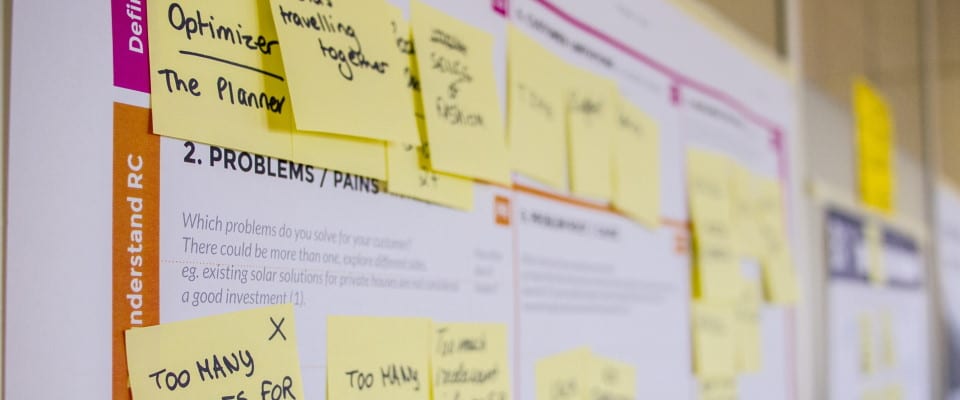Salesforce recently released the Fifth edition of their Small and Medium Business Trends Report. In this article, we’re going to dive into some of the report’s findings of over 2500 responses from SME business owners and leaders across the world and find out what has changed for them over the past year, and how that impacts their future.
Positivity, resilience & determination
Happily, small and medium business owners and leaders continue to exhibit positivity, resilience and determination, despite more than a year of significant change and market volatility. Growth is still a key imperative for over 44% of SMEs.
The study identified key challenges SMEs will face moving forward, as well as the top characteristics of operating a successful SME. And for those of us who are selling products, services and solutions to other businesses (i.e. operating in a Business-to-Business or B2B Context), it’s clear there will be additional implications to be considered if their growth objectives are to be obtained.
Key challenges for SMEs (and their B2B implications)
Bringing innovative offerings to market

This continues to be the top priority for SMEs who are often also seeking how they may be able to generate recurring revenues. It is important to keep in mind that B2B buyers are now seeking “A-I-R”: Advice, Insights, and Recommendations as to how to move their businesses forward to achieve their objectives.
Therefore, consider offering your business clients ACCESS to experts, industry leaders, ongoing support as “value-adds” that you provide in addition to your core offerings. Such access could be offered in the form of forums, workshops, quarterly reviews, allocated blocks of time for advice and support.
These could be offered separately or “bundled” together as a package with your core offerings.
Personalizing customer engagements

B2B buyers now have an increased preference for self-service when researching and purchasing solutions. Over 60% of B2B buyers are completing their research before speaking to any sales representative.
Furthermore, there are now on average 6-8 people involved in the purchase decision process, each of whom will rely upon 5-7 sources of information such as articles, blogs, third party reviews and customer references as part of their research and decision-making.
Hence, it is important that for each of your key clients and prospects, you identify all of the stakeholders involved in the buying decision as well as provide the right kinds of information and resources where your buyers seek information and assistance such as online communities, events, industry and professional associations.
Responding to inquiries quickly

It is important to keep in mind that in a B2B context, responding to your business customers’ inquiries quickly can often be critical in their ability to deliver to their end customers.
Depending on the expectations and requirements of your business customers, consider providing Service Level Agreements or Service Level Guarantees as to when and how you will deal with queries, complaints and technical faults.
Also, consider the appropriateness of implementing technology-based service solutions such as chatbots as a means to quickly address “standard” inquiries.
Acquiring new customers

This continues to be a key challenge for many companies operating in a B2B context given the many changes in behaviours and preferences of B2B buyers.
As a result, it is critical that SME companies operating in B2B consider new ways to gain visibility and reach their target clients including strategic partnerships as well as collaborative endeavours such as joint marketing initiatives or co-creating products and solutions.
Retaining existing customers

The expectations of business customers are ever-changing and increasing due to the highly competitive markets they operate in as well as the increasing/new demands from their end-users.
Therefore, it is imperative that plans are developed and implemented to manage and retain your clients and customers often referred to as Account-Based Marketing (ABM).
Top characteristics for running a successful SME
The Salesforce report also identified the following characteristics for running a successful business. Again, there are specific implications as to how to apply these characteristics in a B2B context.
Market Knowledge
It is important you have a strong understanding of both the current industries and geographic markets that you currently operate in as well as those that you seek to pursue in the future.
Given the rapid pace of change and new developments that are occurring across both, it is important that you stay up to date. Therefore, you should be revisiting and “listening” to the market at least on a quarterly basis.
The following sources can be used to help you to stay current include:
- Industry and Professional Associations
- Publications
- Webinars
- Events
- Customer Advisory Panels
- Communities/Professional Groups
- Relevant Podcasts
- Tip: To identify podcasts use listennotes.com – it’s Google for podcasts!
Flexibility and Agility

As we have all experienced over the past 18 months, it is imperative that companies are aware of and can respond to external changes.
To ensure that your company is up to date of current able to adapt and respond, it is important that you are regularly “listening” to your market and customers and that you are also similarly undertaking a regular “review and reset” of your strategies and customer/ account plans.
Innovative Mindset
The growth and success of your company will be contingent on the leadership team to drive, encourage and help foster a business innovation mindset across the entire organization.
A business innovation mindset means that every team member in the company is focused on proactively identifying new opportunities and/or improvements that can be made within the company—to be better meet the needs of your customers and improve the way the organisation operates.
These can be innovations that are introduced from observing other companies, other industries, other markets. Having an innovative mindset will also mean that your company undertakes the following:
- Regularly “LISTENS” to what’s happening externally—i.e. in Other companies, industries and geographic markets
- Cross-functional teams within the company working together to meet customer needs
- Pursues opportunities to collaborate with customers, suppliers, industry associations
- Encourages experimentation of new ideas as a means to grow and move forward
Conclusion
It’s clear from this 5th edition of Salesforce’s SMB Trends Report there are many existing and new challenges for SMEs that want to reach their business growth targets in 2022.
We took a look at just 5 of the report’s findings, but with over 2500 responses, there are sure to be more gems to be found by business owners like you. You can download your own copy of the SMB Trends report here
If you’ve read the report, what were your takeaways? Did you find anything useful to help your SME reach its goals? Let us know over on Linkedin.

